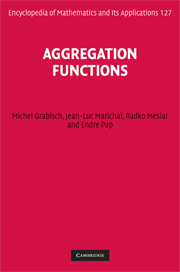Book contents
- Frontmatter
- Contents
- List of figures
- List of tables
- Preface
- 1 Introduction
- 2 Properties for aggregation
- 3 Conjunctive and disjunctive aggregation functions
- 4 Means and averages
- 5 Aggregation functions based on nonadditive integrals
- 6 Construction methods
- 7 Aggregation on specific scale types
- 8 Aggregation on ordinal scales
- 9 Aggregation on bipolar scales
- 10 Behavioral analysis of aggregation functions
- 11 Identification of aggregation functions
- Appendix A Aggregation of infinitely many arguments
- Appendix B Examples and applications
- List of symbols
- References
- Index
Preface
Published online by Cambridge University Press: 05 March 2013
- Frontmatter
- Contents
- List of figures
- List of tables
- Preface
- 1 Introduction
- 2 Properties for aggregation
- 3 Conjunctive and disjunctive aggregation functions
- 4 Means and averages
- 5 Aggregation functions based on nonadditive integrals
- 6 Construction methods
- 7 Aggregation on specific scale types
- 8 Aggregation on ordinal scales
- 9 Aggregation on bipolar scales
- 10 Behavioral analysis of aggregation functions
- 11 Identification of aggregation functions
- Appendix A Aggregation of infinitely many arguments
- Appendix B Examples and applications
- List of symbols
- References
- Index
Summary
The process of combining several numerical values into a single representative one is called aggregation, and the numerical function performing this process is called an aggregation function. This simple definition demonstrates the size of the field of application of aggregation: applied mathematics (e.g., probability, statistics, decision theory), computer sciences (e.g., artificial intelligence, operations research), as well as many applied fields (economics and finance, pattern recognition and image processing, data fusion, multicriteria decision aid, automated reasoning, etc.).
Although the history of aggregation is probably as old as mathematics (think of the arithmetic mean), its existence has remained underground till only recently, and its utilization rather intuitive and hardly formalized. The rapid growth of the abovementioned application fields, largely due to the arrival of computers, has made necessary the establishment of a sound theoretical basis for aggregation functions. Hence, since the 1980s, aggregation functions have become a genuine research field, rapidly developing, but in a rather scattered way since aggregation functions are rooted in many different fields. Indeed, most of the results were disseminated in various journals or specialized books, where usually only one specific class of aggregation functions devoted to one specific domain is discussed.
Actually, in these early years of the twenty-first century, a substantial amount of literature is already available, many significant results have been found (such as characterizations of various families of aggregation functions), and many connections have been made with either related fields or former work (such as triangular norms in probabilistic metric spaces, theory of means and averages, etc.).
Information
- Type
- Chapter
- Information
- Aggregation Functions , pp. xiii - xviiiPublisher: Cambridge University PressPrint publication year: 2009
